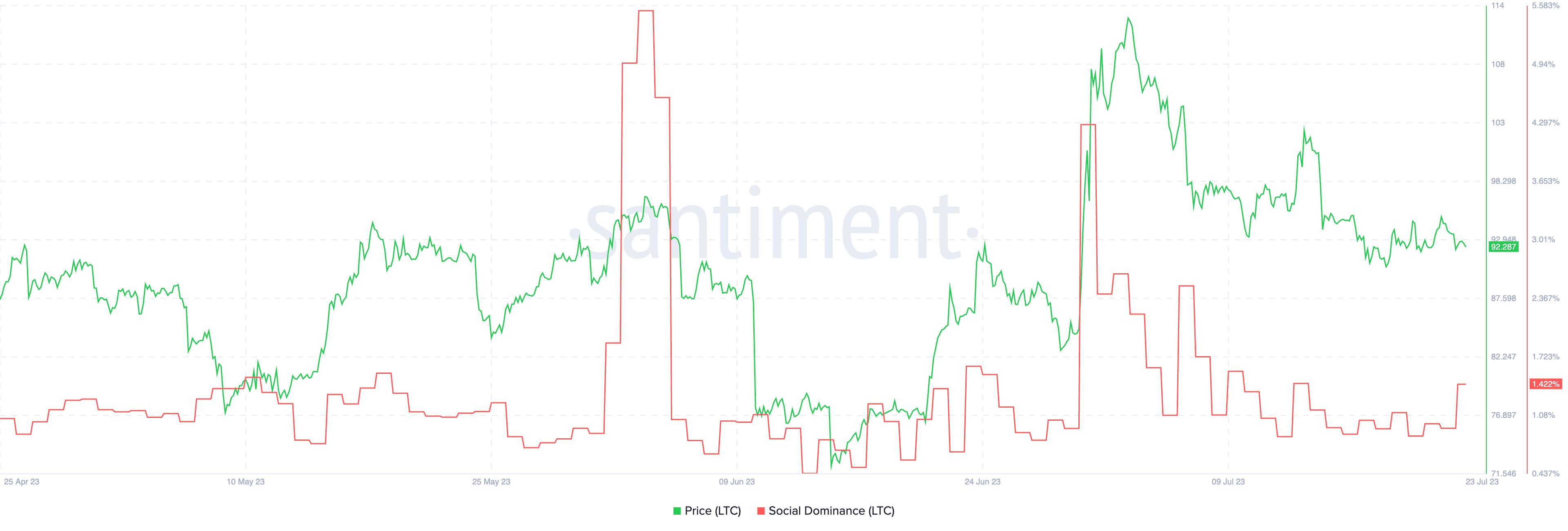- Litecoin whale transactions remain consistently high less than ten days away from the halving event.
- LTC is likely to kick off the alt season rally close to its halving slated to occur on August 2.
- Litecoin’s social dominance is on the rise as the halving event draws close.
Litecoin’s upcoming halving has fueled speculation among LTC holders closer to the event. The halving is scheduled for August 2 according to the Nicehash halving countdown tracker.
LTC holders are enthusiastic about the upcoming event and its potential to catalyze a bullish recovery in the altcoin’s price. This can be measured by the social dominance metric.
Also read: Ethereum, Tron and Bitcoin worth $23 million drained from Alphapo hot wallets
Litecoin on-chain metrics signal LTC holders’ enthusiasm
Litecoin on-chain metrics turned bullish, rising social dominance and increased whale wallet activity signal enthusiasm of the altcoin’s holders. It is likely that the altcoin will lead the alt season rally with its upcoming halving event.
Based on data from crypto intelligence tracker Santiment, social dominance of LTC climbed over the weekend.
Litecoin price vs social dominance
Social dominance in Litecoin has previously coincided with rallies in LTC price. This is typically observed in LTC, with three instances, June 3 and 30 and July 6.
Whale transactions in Litecoin network have stayed consistently high in the weeks leading up to the LTC halving.
Litecoin whale transaction count vs price
The upcoming halving has fueled speculation and hype in the Litecoin community and LTC holders expect an upside in the price of the altcoin in the short term.
EV stocks FAQs
Electric vehicles or EVs are automobiles that use rechargable batteries and electric motors to accelerate rather than internal combustion engines (ICEs). They have been around for more that 100 years, but battery technology research & development was meager for much of the 20th century. Lithium-ion battery technology became advanced enough to produce EVs at scale in the late 1990s and 2000s, and sales have been steadily increasing since then Tesla’s Roadster was unveiled in 2008. EVs are viewed as a means of reducing carbon emissions since battery electric vehicles (BEVs) themselves produce zero emissions. Other vehicles called plug-in hybrid electric vehicles (PHEVs) utilize both battery electric power and ICEs as a backup.
EVs are growing from a small base, but they rose from 9% of global new auto sales in 2021 to 14% of the total in 2022. This was a 65% YoY growth rate, and the industry delivered 10.2 million EVs worldwide in 2022. Projections show this number climbing above 16 million in 2023. Across the world, market shares differ greatly among nations. Nearly 88% of Norwegian new car sales in 2022 were EVs. On the other hand, the United States, where much of the modern innovation in EVs was forged, had less than 8% of new vehicle sales go to EVs in 2022. The largest EV market in the world, China, saw 30% of the market go to EVs that year.
We know you’re thinking Elon Musk, but he’s probably more like the father of the mass-market, contemporary EV. All the way back in 1827, a Hungarian priest named Anyos Jedlik invented the electric motor and used it the following year to power a vehicle of sorts. French scientist Gaston Planté invented the lead-acid battery in 1859, and German engineer Andreas Flocken built the first true electric car for the public in 1888. EVs made up about 38% of all vehicles sold in the US around 1900. They began losing market share rapidly after 1910 when gasoline-powered vehicles grew much more affordable. They largely died off until new research programs in the 1990s led to gradual private sector investment in the 2000s.
China’s BYD is by far the largest manufacturer of EVs in the world. In 2022 it sold 1.8 million EVs and in the second half of the year made up 20% of the global market. The asterisk given to BYD is that the vast majority of these vehicles are hybrids. Tesla’s 12% market share is often treated as more significant than BYD, because it only sells BEVs and is the most famous EV brand in the world. Volkswagen, BMW and Wuling then round out the top five. As a new sector with heavy investment though, many startups have flooded the market. These include China’s Nio, Li Auto and Xpeng; a Swedish-Chinese manufacturer called Polestar; and Lucid and Rivian from the US.
Like this article? Help us with some feedback by answering this survey:












